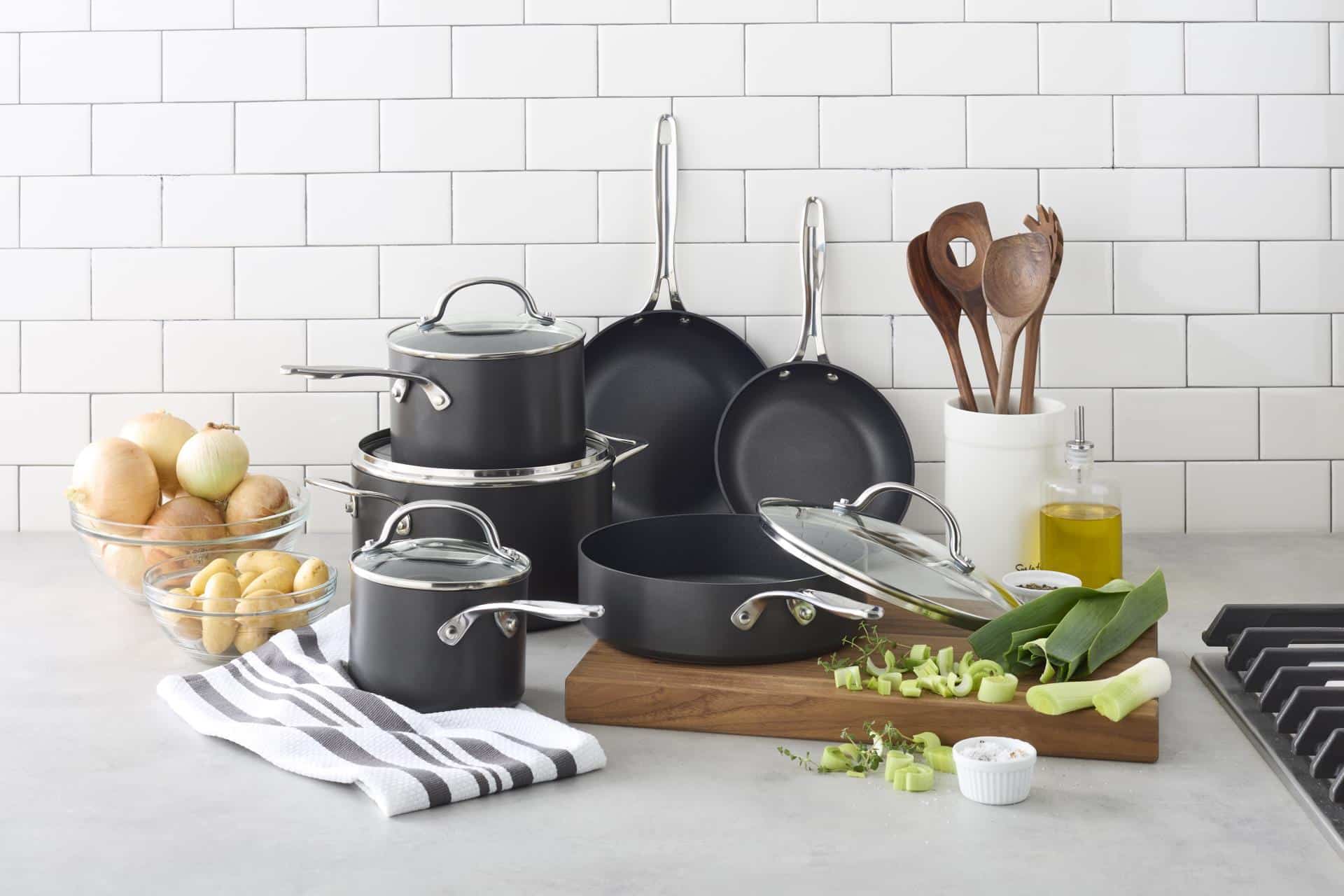Decisions, decisions.


If you’re on the hunt for new pots and pans, you’ve likely encountered these two solid contenders: hard anodized aluminum and ceramic nonstick. Each has its fanbase, swearing by its cooking prowess and ease of use. But what’s the best choice for you?
Whether you’re whipping up a feast for a crowd or just cooking a simple meal for one, understanding the differences between hard anodized and ceramic nonstick cookware can help you make an informed decision. In this article, we’ll explore what sets them apart, how they measure up in the kitchen and what you might want to consider before making your pick.
Hungry for more? Our collection of nonstick cookware has the piece to add to your kitchen, from pans you love like GreenPan, All-Clad, Scanpan and more!
Hard anodized aluminum is cookware made from aluminum that has been electrochemically hardened. This process, known as anodization, transforms the surface of aluminum into aluminum oxide, making it extremely durable and resistant to corrosion without adding any coatings that might peel or chip. This material is favored for its combination of lightweight design, excellent heat conductivity and a nonreactive surface.
Key Benefits:
Ceramic nonstick refers to cookware coated with a layer of ceramic material that provides a nonstick surface. Unlike traditional nonstick coatings, which are often made from chemicals like PTFE (polytetrafluoroethylene), ceramic coatings are derived from natural minerals and offer a safer, more eco-friendly alternative. This type of cookware is favored for its ability to cook with less oil, easy cleanup and resistance to high temperatures.
Key Benefits:
When comparing the cooking performance of hard anodized aluminum and ceramic nonstick cookware, several key factors such as heat distribution, temperature tolerance and suitability for various cooking methods come into play.
Each material offers unique benefits and limitations that can affect the outcome of your culinary creations.
Hard anodized aluminum stands out for its superior heat conductivity, ensuring even heat distribution. This quality is beneficial for achieving consistent cooking results, especially in recipes requiring precise temperature control.
Ceramic nonstick cookware offers great heat distribution that, while slightly slower to respond than hard anodized aluminum, effectively supports most cooking tasks—particularly those benefiting from gentle heat.
Ceramic nonstick coatings are noted for their high heat resistance, often more so than traditional nonstick coatings. This quality allows for cooking at higher temperatures without the risk of damaging the surface, making ceramic cookware suitable for a variety of cooking tasks, including those that require searing or baking at elevated temperatures.
However, it’s important to note that while ceramic can handle higher temperatures better than traditional nonstick, hard anodized aluminum typically offers a broader temperature range—especially for oven use—due to its metal base and lack of reliance on a coating.
The robust nature of hard anodized aluminum makes it adept for a variety of cooking methods, from high heat searing to simmering acidic foods without flavor alteration. On the other hand, ceramic nonstick is particularly useful for cooking where nonstick properties are essential, such as with eggs, fish or pancakes, and might be a better choice for those prioritizing health and environmental benefits through a PTFE- and PFOA-free surface.
The durability and maintenance of cookware is crucial to ensuring it remains a reliable part of your kitchen arsenal for years. Hard anodized aluminum and ceramic nonstick cookware each offer distinct advantages in these areas, with specific care required to maintain their best condition.
Hard anodized aluminum is known for its exceptional toughness. The process of anodizing aluminum makes its surface resistant to scratches, chipping and peeling, which plays a crucial role in its longevity. This material also stands up well to high heat, preventing warping and maintaining its shape and functionality over many years.
Ceramic nonstick, on the other hand, offers a durable nonstick surface that’s environmentally friendly. While it avoids the use of certain chemicals found in traditional nonstick coatings, it may be more vulnerable to scratches. The ceramic coating can chip more easily than hard anodized aluminum, especially if metal utensils or abrasive cleaning tools are used, which might shorten its lifespan.
Hard anodized aluminum boasts a scratch-resistant surface, making it more forgiving if metal utensils are used. However, to preserve the aesthetic and integrity of the surface for as long as possible, opting for wooden, silicone or plastic utensils is still a wise choice. And though hard anodized cookware is often dishwasher safe, handwashing with mild detergent and a soft sponge is recommended to avoid the harsh conditions of a dishwasher that could affect its finish over time. Using abrasive cleaners or scouring pads should be avoided to maintain the cookware’s appearance and performance.
When it comes to ceramic nonstick cookware, the emphasis is on protecting the nonstick surface to extend its usability and maintain its easy-clean properties. Using wooden or silicone utensils can prevent scratches that metal utensils might cause, and although many ceramic pieces are dishwasher safe, handwashing them can significantly extend their life.
Proper storage is key for both types. Whether hanging or using protectors when stacking pans, it helps prevent damage such as chips or excessive wear. By taking these steps, you can ensure your cookware remains in top condition.
For hard anodized aluminum cookware, while it is more scratch-resistant than many other types, using wooden, silicone or plastic utensils can help maintain its condition longer. For ceramic nonstick cookware, it’s best to avoid metal utensils altogether to prevent scratching the nonstick surfaces.
Many hard anodized aluminum and ceramic nonstick cookware pieces are labeled as dishwasher safe. However, handwashing with mild detergent is recommended to extend the lifespan of the cookware. Dishwasher detergents can be harsh and may degrade the finish over time.
Ceramic nonstick cookware can generally withstand higher temperatures than traditional nonstick coatings, making it suitable for a variety of cooking methods. However, to preserve the life of the nonstick surface, it’s advisable not to exceed medium-high heat.
Hard anodized aluminum cookware is not naturally induction compatible because aluminum doesn’t work with induction cooktops. However, some hard anodized aluminum cookware comes with a magnetic base that makes it suitable for induction cooking. Check the manufacturer’s specifications to be sure.
Ceramic nonstick cookware is versatile and suited for most types of cooking. However, using it for very high-heat cooking like searing meat might not be ideal, as consistent exposure to very high temperatures over time can potentially lead to wear and reduce the effectiveness of the nonstick surface.
Hungry for more? Our collection of nonstick cookware has the piece to add to your kitchen, from brands you love like GreenPan, All-Clad, Scanpan and more!
JOIN THE CONVERSATION